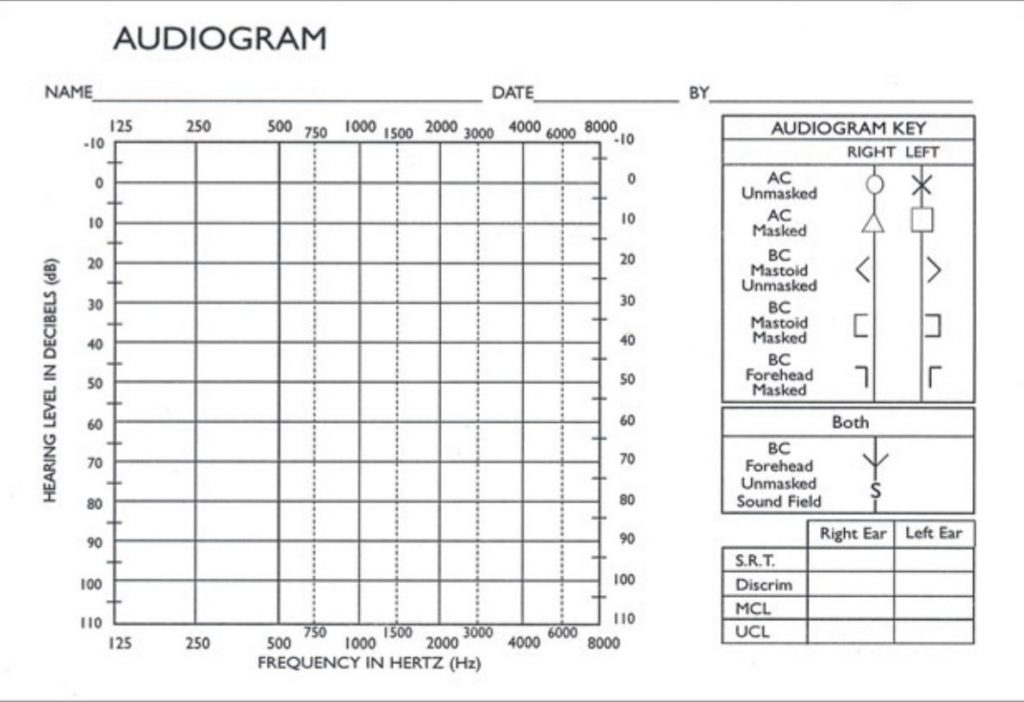An audiogram is a graphical representation of hearing ability in terms of Frequency and Intensity. Human ear is capable of hearing sounds as soft as a sound made by a leaf in quiet environment. Human hearing ranges between 20Hz to 20KHz. Testing all the range of frequencies are not practically possible. We all communicate through speech; if a person is unable to hear speech bothers more than if he is not aware of the environmental sounds.
So, any Audiologist focus to asses hearing at speech frequencies than other frequencies. Speech is a complex signal that consists of frequency scattered from 250Hz to 6KHz, depending on the place of speech production and manner of production, the frequency varies for each sounds in speech. That is the reason why you see an audiogram plotted between 250Hz to 8KHz.

Different Degrees (Levels) of Hearing Loss
Hearing threshold can vary from person to person and ear to ear even in person with hearing sensitivity within normal limits. The levels of hearing loss are typically defined as follows:
Slight Hearing loss: 15dBHL-25dBHL
This level of hearing loss applies only to children. Children who have hearing loss in this range are defined as having a “slight” hearing loss. These children will not need hearing aids but should be monitored on a frequent basis to verify the hearing loss is not progressing and also the academic performance at school.
Mild hearing loss: 25dBHL-40dBHL
In children, a “mild” hearing loss is not a slight problem: a mild hearing loss can cause major difficulties with articulation and some language acquisition skills too. People with a mild hearing loss often miss or get confused with the softer consonant sounds like s, t, th, and f. Hearing becomes even more difficult in the presence of background noise. Children with hearing in this range benefit from the use of hearing aids with mild gain. One should check also check for loudness tolerance problem while fitting hearing aids.
Moderate hearing loss: 41dBHL-55dBHL
This is a moderate hearing loss. The newborn hearing screening program is designed to pick up hearing losses in the moderate range (or greater). Individuals with moderate hearing loss will require hearing aids for conversation and children will need intervention with auditory verbal therapy to obtain age-appropriate speech and language skills. Moderate hearing loss also affects performance at school if left unattended.
Moderately Severe hearing loss: 56dBHL-70dBHL
Individuals with this level of hearing loss cannot hear any of the sounds of speech at typical conversational levels without hearing aids. Children will require auditory therapy and hearing aids to obtain age appropriate speech and language skills. Intensive speech therapy and follow up will help to prevent these children getting away from peer group interaction.
Severe hearing loss: 71dBHL -90dBHL
Hearing aids begin to lose effectiveness as the degree of hearing loss increases, due to sound distortion (caused by the amplified signal and the missing inner hair cells in the cochlea). Powerful hearing aids are beneficial to some individuals, while others will use cochlear implants to obtain access to sound.
Hearing aids or cochlear implants, along with auditory rehabilitation therapy are necessary to develop age-appropriate speech and language skills in children.
Profound hearing loss: Greater than 91dBHL
Hearing aids are generally not effective for obtaining all of the sounds of speech with this level of hearing loss. Some young children will wear hearing aids to stimulate the auditory nerve until a cochlear implant is obtained.
Cochlear implants are able to provide access to all of the sounds of speech, so that many children who obtain implants and have early auditory rehabilitation therapy are able to develop age-appropriate speech and language skills. If an auditory-oral method of training is not selected, children can develop language through the use of sign language.
Audiogram
Audiogram is an graph of an individual’s hearing ability.
- On an Audiogram, the frequency, or pitch of the sound, is mentioned along the horizontal axis. Lower pitched sounds (bass drum) are on the left-hand side of the chart, and higher frequency sounds (shrill, bird chirping) are along the right-hand side of the chart. For the purposes of human speech, the important frequencies are from 250Hz – 8,000Hz. For reference purposes, Middle C on a piano is at 250 Hz.
- The volume or the loudness of the sound is along the vertical axis. Sound volume increases down the length of the chart. Sound is measured in decibels (dB), which does not increase in a linear fashion. 50dBHL is much, much louder than 10dBHL.
- The “speech banana” is the figurative area on an audiogram where individual speech sounds take place. The speech banana superimposed on the audiogram on the right is an English speech banana: each language has its own sounds of speech, and its own speech banana. Low frequency sounds like “M” and “Z” are on the left, and high frequency sounds like “F” and “S” are on the right.
Comments are closed.